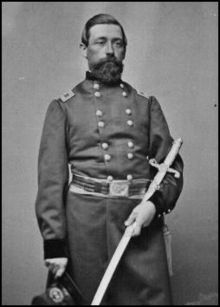James Nagle
James Nagle (born April 5, 1822 in Reading , Pennsylvania , † August 22, 1866 in Pottsville , Pennsylvania) was a US Army soldier in the Mexican-American War and a brigadier general in the Civil War .
Life
Mexican-American War
Nagle organized the construction of an artillery battery in Washington in 1842 and joined the 1st Pennsylvania Volunteers as a volunteer after the start of the Mexican-American War in 1846. His regiment was stationed in Perote to maintain communication with the siege troops during the siege of Veracruz . In the following years he led a group of guerrillas to La Hoya and participated in battles in Huamantla, Puebla and Atlixco before he was used in the conquest of Mexico City . Most recently he was stationed in San Angel until the end of the Mexican-American War. On July 27, 1848, he and his company in Philadelphia were retired from active military service. For his military service he was awarded a sword by Schuylkill County .
Civil War
At the beginning of the Civil War in 1861 he received the commission as a colonel in the 6th Pennsylvania Regiment and shortly thereafter received the order to build up the 48th regiment, in which he became a colonel. In the following years he served in Fort Monroe, the Hatteras Islands and Newbern and commanded a brigade of the 9th Army Corps in the second battle of the Bull Run in late August 1862. Shortly afterwards, on September 10, 1862, he was appointed Brigadier General of the Volunteer Forces and played in this position played a leading role in holding the bridge during the Battle of Antietam under the command of Major General George B. McClellan on September 17, 1862. After his appointment expired on March 4, 1863, this was renewed on March 13, so that he resigned with his brigade in Kentucky by May 9, 1863 and then because of his poor health.
After troops of the Confederate States Army under Robert Edward Lee marched into Philadelphia in June 1863, Nagle built the 39th regiment of the Pennsylvania militia and received the commission as its colonel. He then commanded a brigade and was retired on August 2, 1863. In 1864 he organized the commissioning of the 149th Pennsylvania Regiment for a hundred-day service, became its colonel and guarded the entrances to Baltimore until the end of his service .
See also
literature
- Nagle, James . In: James Grant Wilson, John Fiske (Eds.): Appletons' Cyclopædia of American Biography . tape 4 : Lodge - Pickens . D. Appleton and Company, New York 1888, p. 475 (English, Textarchiv - Internet Archive ).
Web links
- James Nagle in the database of Find a Grave (English)
| personal data | |
|---|---|
| SURNAME | Nagle, James |
| BRIEF DESCRIPTION | American Brigadier General of the Northern States in the American Civil War and soldier in the Spanish-American War |
| DATE OF BIRTH | April 5, 1822 |
| PLACE OF BIRTH | Reading , Pennsylvania |
| DATE OF DEATH | August 22, 1866 |
| Place of death | Pottsville , Pennsylvania |
